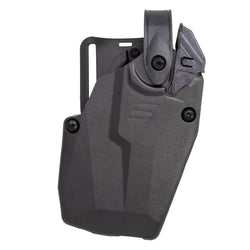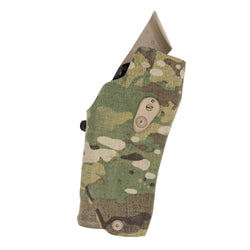Sometimes, having the latest and greatest can be a mark against you. Revolvers have gotten lighter and easier to carry as time has marched on. If you are opting for a revolver today, chances are that it is the lightweight snub nose variety. These handguns feature short grips, short barrels, and featherlight aluminum, scandium, and polymer frames.
That makes them easy to carry—but punishing to shoot.
The snubbie is rightfully seen as something of an expert’s gun, despite its simple controls, which should make it beginner-friendly.
Although airweight snubbies are the most common configuration out there, steel-framed revolvers are still available. They remain both the low-tech and best-tech way to get into the revolver platform without the worst misgivings.
Perhaps one of the best small revolvers to buy is also one that has been around for decades and is still going strong: the Ruger SP101.

Ruger SP101: The Last Great All-Steel Revolver
In the days when cops carried revolvers, steel-framed handguns from Colt & Smith & Wesson were the default.
In the 1970s, Ruger—already known for its investment-cast handguns like the Standard .22 and the Super Blackhawk in .44 Magnum—belatedly got into the law enforcement market with the Ruger Security Six in .357 Magnum.
In the late 1980s, just as law enforcement departments began to look more strongly at semi-automatic handguns, Ruger simplified the Security Six with the launch of the GP100. Alongside it came its smaller brother, the SP101.
The SP101 is an all-stainless steel revolver that originally debuted in either .357 Magnum or .38 Special, with a 2 ¼-inch barrel. In this configuration, it was briefly adopted by the NYPD and the State Department.
Soon after, a 3-inch variant was added, along with new caliber options—.22 LR, .32 H&R Magnum, and 9mm. In 2007, the SP101 became the debut platform for the new .327 Federal Magnum cartridge.
During the 2010s, Ruger added a 4 ¼-inch model with adjustable sights. Despite the launch of the lightweight LCR line, the SP101 remains a popular seller. The mainline model is still the 2¼-inch snubby chambered in .357 Magnum.
While I began as a Smith & Wesson revolver shooter, I have carried an LCR on occasion. I went shopping for another lightweight snubbie in 2020, but all the popular models were off the shelf, leaving only a few steel-framed options when I could find a revolver at all.
I ended up with a Ruger SP101 DAO model with a 2 ¼-inch barrel. After five years of ownership and hundreds of rounds downrange, here is how the SP101 does:
Ruger SP101 Quick Specs
- Caliber: .38 S&W Special/.357 Magnum
- Capacity: 5 rounds
- Barrel Length: 2 ¼ inches
- Overall Length: 6 ¾ inches
- Width: 1 5/16 inches
- Weight: 1 lb. 12 oz. (loaded)
- Grips: Monolithic Rubber Grip w/ Polymer Inserts
- Action: Double-Action Only Hammer-Fired
Unchanging Features
The base SP101 is a brushed stainless steel revolver that holds five rounds of .357 Magnum ammunition. It also accommodates the shorter and lighter-kicking .38 Special cartridge.
Like other Ruger revolvers, it is investment cast rather than forged. It is slightly thicker in all dimensions than its Colt or Smith & Wesson counterparts as a result.
Most notable is the bull barrel and full underlug that retains the ejector rod. The barrel is slab-sided along the sighting plane and wears a pin-removable black ramped front sight. Up top, the frame has a wide, square-grooved channel
The Ruger SP101 is a double-action revolver. Pressing the trigger all the way rearward rotates the cylinder and drops the hammer.
Most versions feature an exposed hammer that can be thumb-cocked for a lighter, shorter single-action trigger pull. My DAO model is set up in the NYPD configuration. It has a bobbed hammer with no single-action notch. It is snag-free but can only be fired in double action.
The only other visible control on the SP101 is the cylinder release, located on the left side behind the cylinder. It’s a simple push-button design. Press inward with your thumb to unlock and swing the cylinder out for loading or unloading.
On the inside, the Ruger SP101 lacks some of the spit and polish assigned to other revolvers. There are some slight mill marks and a few sharp edges.
But where the SP101 lacks in polish, it shines in sheer simplicity.
It features no side plates or screws to lose, and the trigger group is dovetailed into the frame for easy removal and maintenance.
Unlike other revolvers, the SP101 doesn’t have a conventional grip frame. Instead, any grip used will simply wrap around a smaller tang where the hammer spring is housed.
The Ruger SP101 comes from the factory wearing a pair of closely-fit rubber grips with hard plastic grip panels. Although I am a fan of switching my grips to a good piece of wood, I have kept the stock grips. They do not add any bulk and are small enough not to interfere with a speedloader.
As it happens, the Ruger SP101 five-shooter takes the same Safariland Comp I loaders as the Smith & Wesson J-Frame. Likewise, J-frame leather holsters like the Bianchi Professional fit snugly as well.

On the Range with the Ruger SP101
At first glance, a snubnosed revolver chambered in .357 Magnum is not useless, but it is perhaps the worst possible configuration for either everyday carry or home defense.
The .357 is a gold standard caliber for service handguns, but downsizing it comes with trade-offs. Going too small punctuates felt recoil and muzzle rise while the shorter barrel bleeds some of the Magnum’s formidable velocity. In fact, when Smith & Wesson first went to the .357 for its smallest J-frame frame guns, the rounds had to be loaded down. Existing Magnum ammunition would pop the guns.
The SP101 predates those little J-frames and can take the punishment. As it happens, you likely can too. The extra weight and full grip of the SP101 make it surprisingly controllable. The SP101 rides the knife’s edge—just big enough to run competently, just small enough to carry without stepping up to a larger frame.

A Big Little Gun
On the range, the Ruger SP101 handles like a big, little gun compared to the typical snubbie you might throw in your back pocket or your range bag.
In the hand, the stock wrap-around rubber grips with polymer inserts are inoffensive. They provide just enough surface area for a full firing grip without being too bulbous for carry. Likewise, the bull barrel gives the SP101 a slight muzzle-heavy feel, which helps stabilize the gun in hand and allows for the small sights to fall back in place after recoil.
Controls and Reloading
Unlike smaller snubbies, you are not left grasping at diminutive controls for loading and unloading. The cylinder release is easy to depress, but you are not likely to bump it by accident. Press it while drawing the cylinder out with your opposite hand.
Loading is simple—drop in five cartridges and close the cylinder. Alternatively, you can use Bianchi Speed Strips or Safariland Comp I loaders if you need to move more quickly. The grip is substantial enough to enable a quick reload, but relieved so that loaders will not get tangled up in the process.
After firing all five rounds, the empty cases are extracted by opening the cylinder and hitting the ejector rod smartly with your hand.
Why the SP101?
I’ve long looked for a smallish, steel-framed revolver that will probably be a mostly .38 Special shooter with .357 Magnum capability and shootability as a bonus. The Smith & Wesson Model 60 and Colt Viper technically live in this class, but I continue to go back to the Ruger SP101.
The controls are smaller, but I am never left grasping for something that is not there. The sights are small, but the black outline of the front sight is easy to find in all but the lowest light. The bull barrel naturally brings the sights back onto the sighting plane for the next shot.
Although the front sight can be changed, I haven’t needed to. The fixed sights of this revolver generally hit close to my point of aim, whether I am using 110-grain all the way up to 158-grain .357 Magnum or .38 Special loads.

Smoothing Out the Trigger
Initially, this SP101 came from the factory with a trigger that was on the grittier side and broke at about 9 lbs. Some lubrication and dry fire practice smoothed up the trigger.
Later, I added an MCarbo rebound spring and hammer spring and got the trigger pull down to a smooth 6 lbs. 7 oz. It is long, so you are not likely to discharge the SP101 accidentally, but it is smooth.
With good trigger control, it is easy to get hits out to 25 yards on steel using any variety of .38 Special ammunition.
Ammunition and Recoil
Recoil with standard pressure and non-+P defensive ammo—like Hornady’s 110-grain FTX—is mild. It’s easy to run through five rounds and wonder where they went.
There’s more blast with .38 Special +P ammunition, but only a slight increase in recoil. My favorite carry ammunition in this revolver is the old school FBI load: Federal’s 158-grain +P lead semi-wadcutter hollow point. The shorter .38 cases are likewise easy to load and eject. With higher-pressure .357 Magnum loads, a firm hit to the ejector rod is needed to clear the longer cases.
From a shooting perspective, launching Magnums out of the SP101 is neither pleasant nor painful. The thicker circumference of the stock grip and steel frame helps to soak up Magnum recoil. My hand does not have any free space to get whacked on the trigger guard, nor is the grip so thin that the web of my hand takes a beating.
The extra noise and blast of the .357 Magnum can catch you off guard. But with proper trigger control, it is possible to make effective hits—and get through a box of ammo without needing to fetch some KT Tape and Tylenol.

Ruger SP101: The One Small Revolver You Should Own
The Ruger SP101 is an old design that continues to take up space on gun store shelves—for good reason.
Revolvers aren’t for everyone, and even among those who choose one, it’s easy to pick the wrong kind. It may be tempting to get the latest, greatest, and lightest platform. Some of those can make great carry handguns, but they can be dubious to shoot, especially as you move up the caliber ladder.
Most snubbies are in .38 Special. An increasing number are available in .357 Magnum. While small guns in these calibers can be asinine, not all revolvers are created equal. For a few extra ounces, the Ruger SP101 with an appropriate load makes the revolver platform far more approachable. If you are going to own only one revolver, the SP101 should be on your short list.











